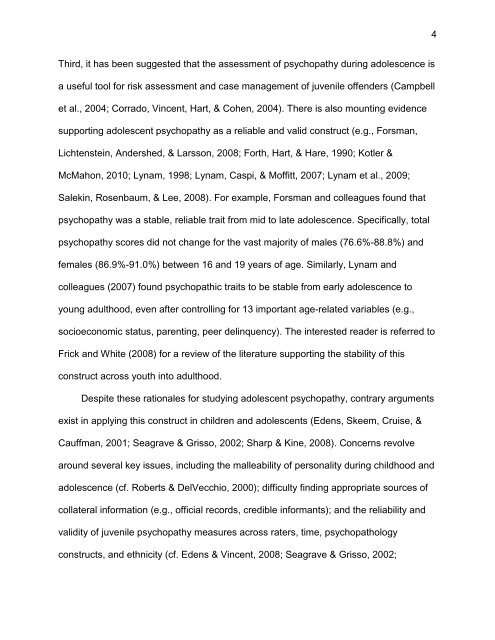an examination of the factor structure of the psychopathy checklist
an examination of the factor structure of the psychopathy checklist
an examination of the factor structure of the psychopathy checklist
You also want an ePaper? Increase the reach of your titles
YUMPU automatically turns print PDFs into web optimized ePapers that Google loves.
Third, it has been suggested that <strong>the</strong> assessment <strong>of</strong> <strong>psychopathy</strong> during adolescence is<br />
a useful tool for risk assessment <strong>an</strong>d case m<strong>an</strong>agement <strong>of</strong> juvenile <strong>of</strong>fenders (Campbell<br />
et al., 2004; Corrado, Vincent, Hart, & Cohen, 2004). There is also mounting evidence<br />
supporting adolescent <strong>psychopathy</strong> as a reliable <strong>an</strong>d valid construct (e.g., Forsm<strong>an</strong>,<br />
Lichtenstein, Andershed, & Larsson, 2008; Forth, Hart, & Hare, 1990; Kotler &<br />
McMahon, 2010; Lynam, 1998; Lynam, Caspi, & M<strong>of</strong>fitt, 2007; Lynam et al., 2009;<br />
Salekin, Rosenbaum, & Lee, 2008). For example, Forsm<strong>an</strong> <strong>an</strong>d colleagues found that<br />
<strong>psychopathy</strong> was a stable, reliable trait from mid to late adolescence. Specifically, total<br />
<strong>psychopathy</strong> scores did not ch<strong>an</strong>ge for <strong>the</strong> vast majority <strong>of</strong> males (76.6%-88.8%) <strong>an</strong>d<br />
females (86.9%-91.0%) between 16 <strong>an</strong>d 19 years <strong>of</strong> age. Similarly, Lynam <strong>an</strong>d<br />
colleagues (2007) found psychopathic traits to be stable from early adolescence to<br />
young adulthood, even after controlling for 13 import<strong>an</strong>t age-related variables (e.g.,<br />
socioeconomic status, parenting, peer delinquency). The interested reader is referred to<br />
Frick <strong>an</strong>d White (2008) for a review <strong>of</strong> <strong>the</strong> literature supporting <strong>the</strong> stability <strong>of</strong> this<br />
construct across youth into adulthood.<br />
Despite <strong>the</strong>se rationales for studying adolescent <strong>psychopathy</strong>, contrary arguments<br />
exist in applying this construct in children <strong>an</strong>d adolescents (Edens, Skeem, Cruise, &<br />
Cauffm<strong>an</strong>, 2001; Seagrave & Grisso, 2002; Sharp & Kine, 2008). Concerns revolve<br />
around several key issues, including <strong>the</strong> malleability <strong>of</strong> personality during childhood <strong>an</strong>d<br />
adolescence (cf. Roberts & DelVecchio, 2000); difficulty finding appropriate sources <strong>of</strong><br />
collateral information (e.g., <strong>of</strong>ficial records, credible inform<strong>an</strong>ts); <strong>an</strong>d <strong>the</strong> reliability <strong>an</strong>d<br />
validity <strong>of</strong> juvenile <strong>psychopathy</strong> measures across raters, time, psychopathology<br />
constructs, <strong>an</strong>d ethnicity (cf. Edens & Vincent, 2008; Seagrave & Grisso, 2002;<br />
4

















